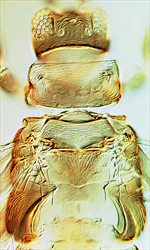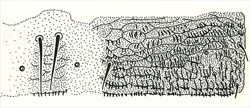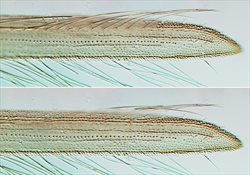
Head & thorax

Antenna

Meso & metanota

Metathoracic furca

Tergite V

Tergites IV-V

Ventral & dorsal images of fore wing apex
Both sexes fully winged. Body and legs brown, tarsi and apex of hind tibiae paler; antennal segments III–V slightly paler than II and VI; fore wing uniformly shaded greyish-brown. Antennae 8-segmented but segment VI with an oblique partial suture producing a 9-segmented condition; segments III–IV each with a forked sense cone. Head and pronotum with no long setae; maxillary palps 2-segmented. Metanotum with elongate reticulation, median pair of setae small and arising medially. Metathoracic furca lyre-shaped, extending into mesothorax. Tarsi all 1-segmented. Fore wing apex bluntly rounded, antero-marginal cilia arising ventrally behind apparent margin, veinal setae minute, postero-marginal cilia straight. Abdominal tergites II–VIII median setae long and close together; lateral thirds of tergites with reticulations bearing internal ridges; VIII with short postero-marginal comb of microtrichia. Sternites III–VII with three pairs of small postero-marginal setae.
There are about 55 species listed in the genus Dendrothrips, of which only four are known from Britain, with a further five from elsewhere in Europe. Most species in this genus are known from Africa, Asia and Australia. They all have the metathoracic furca elongate and "lyre-shaped", as do other members of the Dendrothripinae (Mound & Tree, 2016). However, in Dendrothrips species the fore wing is unusual with the antero-marginal cilia arising ventrally and well-behind the apparent anterior margin. D. degeeri is similar to ornatus in having minute pronotal posteroangular setae, but has the fore wing uniformly shaded not banded.
Feeding, breeding and pupating on the leaves of a range of unrelated trees and shrubs, particularly Fraxinus but including Alnus, Aesculus, Corylus, Tilia and Ulmus.
Widespread and fairly common in southern England (Mound et al., 1976), in recent years D. degeeri has also been collected from various locations in Yorkshire (e.g., Collins, 2006), as far north as Richmond. This species is widespread in Europe from Spain to Norway to the Urals (zur Strassen, 2003), and has also been recorded from Iran (Minaei, 2013).
THRIPIDAE - DENDROTHRIPINAE
Dendrothrips degeeri Uzel
Dendrothrips Degeeri Uzel, 1895: 162
Dendrothrips invidiosa Priesner, 1926: 177
Dendrothrips orni Priesner, 1966: 66
Collins DW (2006) Odontothrips confusus Priesner (Thysanoptera: Thripidae) new to Britain and recent records of other British thrips. British Journal of Entomology and Natural History. 19: 145–156.
Minaei K (2013) Thrips (Insecta, Thysanoptera) of Iran: a revised and updated checklist. ZooKeys 330: 53–74.
Mound LA, Morison GD, Pitkin BR & Palmer JM (1976) Thysanoptera. Handbooks for the Identification of British Insects 1 (11): 1–79.
Mound LA & Tree DJ (2016) Genera of the leaf-feeding Dendrothripinae (Thysanoptera, Thripidae), with new species from Australia and Sulawesi, Indonesia. Zootaxa 4109 (5): 569–582.
zur Strassen R (2003) Die terebranten Thysanopteren Europas und des Mittelmeer-Gebietes. Die Tierwelt Deutschlands 74: 1–271.